 This Golden Retriever article has been compiled as part of the IPFD's series to highlight the Big Picture of health, welfare and breeding and to help develop Globally Relevant Integrated Health Profiles (GRIHPs) for many breeds. The creation of this content has been supported by the Morris Animal Foundation.
This Golden Retriever article has been compiled as part of the IPFD's series to highlight the Big Picture of health, welfare and breeding and to help develop Globally Relevant Integrated Health Profiles (GRIHPs) for many breeds. The creation of this content has been supported by the Morris Animal Foundation.

♦ Read about the Morris Animal Foundation's Golden Retriever Lifetime Study – the largest prospective, longitudinal study in veterinary medicine in the United States.♦
DENVER/June 6, 2022 – ARTICLE MAF: Update on Golden Retriever Lifetime Study Published... As the Morris Animal Foundation Golden Retriever Lifetime Study approaches its 10th anniversary, a newly published paper in the journal PLOS ONE reviews the study’s findings to date and previews research in progress.
Cohort profile: The Golden Retriever Lifetime Study (GRLS) - Published: June 9, 2022
See IPFD's Get a GRIHP! on Breed Health Initiative.
There are many others doing great work to advance heath, well-being, and welfare in this wonderful breed. We reference and link to terrific work, developments, reports, and research from the UK, USA, Sweden, Finland and more below. Thanks to all of those working on behalf of Goldens.
This is a 'living document' - so if anyone has more material to share or point us to - please let us know!
Table of Contents
Breed At a Glance - Golden Retrievers
The Golden Retriever breed originated in Great Britain. For over 100 years Golden Retrievers have served as hunting companions - specialists in retrieving waterfowl and upland game. Golden Retrievers are a popular dog breed in many parts of the world today, frequently fulfilling roles as companion pets.
The breed continues to be developed to possess an amiable temperament, willingness to work and a sturdy physique. Today Goldens mainly fulfill roles as family companions and show dogs. Some people demonstrate their dog's working abilities in performance competitions/field trials, and the breed is well represented as service/guide dogs, therapy dogs, search and rescue dogs, detector dogs, and more.
Golden Retrievers - individually and as a breed - are relatively healthy, most living to between 9 to 14 years of age. Key health conditions are list immediate below with more details further below. Breeders and owners alike place the highest value on maintaining good character, intelligence and working abilities in this breed. However, like any popular breed, some breeders of dogs are not always of the highest quality, and consumers need to research not only the breed but the source of the dog.
The population of registered Golden Retrievers has remained relatively stable in some counties over the past decade. Notable exceptions are moderate increases in Goldens registered by the kennel clubs in France and the UK. See statistics below. Working and show/companion lines are distinctly represented.
Key Health Conditions -The Basics: Golden Retriever
CONTEXT: the list of key health conditions is based on a review of educational content and data available from, e.g., IPFD’s Kennel Club Partners and Golden Retriever breed club websites; Agria Sweden pet insurance data and breed profiles; other veterinary practice data; and peer reviewed research. The health conditions are identified by experts, breed-health advisors, owners, and available evidence as those affecting health, quality of life, and welfare for affected individual dogs and/or creating issues and management challenges at a breed level. Key health conditions listed do not represent all health challenges in a breed, but are generally recognized as occurring or emerging in the breed; most are important to consider in breeding decisions. This section highlights key conditions - details, further data and more information, breed-specific programs for various conditions, the international breed population - and more - follows further below.
Golden Retrievers are relatively healthy and long-lived; the key/well-recognized issues in the Golden include problems of the locomotor system (joints/muscles, skeleton), various eye conditions, and in some regions, cancer. Many conditions that impact Goldens' length and quality of life have both heritable and environmental influences. For some health concerns there are genetic tests - but availability of tests does not necessarily mean the specific condition is the most common or serious (see stats below). Screening tests - including clinical exams, radiographs (hips/elbows), or genetic/DNA tests - are important in screening potential breeding animals, as well as for diagnosis in individual dogs.
! News Flash: Being able to move and see is important !
Orthopedic/musculoskeletal/locomotor: hip and elbow dysplasia (HD and ED) are of primary concern; patella, shoulder and spinal or other musculoskeletal conditions can occur. Some of these issues can occur in relatively young dogs. See evaluations of national programs below.
Eye conditions/diseases: multiple eye conditions and diseases may affect dogs in this breed; conditions are detectable by a clinical exam by a veterinarian or veterinary ophthalmologist. DNA tests are available for some eye conditions - and although important, especially for breeding decisions, DNA tests are not a replacement for clinical evaluation.
Quote
More on Eye Health...
Conditions detected by clinical exam include, e.g.:
-
General Vision: Blindness
-
Eyeball: cataracts, lens problems
-
Eyelids: e.g. entropian, ectropian, dystikiasis
-
3rd Eyelid: cherry eye, haw
Conditions detected by genetic tests include, e.g
Cancer: Although cancer is identified internationally as a common cause of death in Goldens, they are not the breed with the highest risk, rates, or lowest age of occurrence for cancer, although the statistics may be different across regions and populations. However, because they are a very common breed, veterinarians and specialists see many Goldens with cancer. There seem to be some cancers that take Goldens at a relatively young age, but many Goldens who live long lives may eventually die of cancer. Better population-based statistics are needed from various regions. The Morris Animal Foundation's Golden Retriever Lifetime Study will shed light on this issue, especially for Goldens in the USA. See more information below.
Skin and Ear Problems: These are frequently seen in Goldens, often related to activities, e.g. swimming. Veterinarians can instruct owners on the best prevention for dogs prone to chronic problems with infections.
What do Caretakers of Golden Retrievers need to Know?
-
Goldens are typically energetic, tractable, active, and require early training and socialization to become high-value companions and canine good citizens. They are seen as friendly and playful, and they tend to 'love' everyone.
-
Fitness: health and well-being of Golden retriever dogs is enhanced through providing regular age- and condition-appropriate exercise and mental stimulation/training activities.
-
Excess weight/body condition score: Hip and elbow dysplasia are common disorders in larger dog breeds – Goldens included. Structural shortcomings in hips, elbows and other musculoskeletal systems are factors that contribute to development of osteoarthritis, lameness and reduced mobility. Numerous purebred dog studies have shown that dogs that are heavier than their breed/sex average have increased odds of experiencing clinically significant issues requiring medical or surgical management. Age at spay or neuter may influence these factors, but more and better evidence is needed on this controversial issue.
-
 Owner awareness of health and temperament considerations - be alert for the signs of physical or mental problems and seek assistance and/or veterinary treatment early.
Owner awareness of health and temperament considerations - be alert for the signs of physical or mental problems and seek assistance and/or veterinary treatment early.
-
It is important for pre-purchase buyers and owners (including breeders) to embrace the value of available health, genetic and other screening tests that are recommended or required to address breed-specific conditions and utilize appropriate management methods that can maximize health, welfare and longevity of Golden Retrievers.
-
They are - after all - retrievers!
Statistics and Health Strategies
CONTEXT: We are pleased to be able to highlight a selection of internationally-based Health Strategy Providers who offer content-rich statistics and in-depth, up-to-date information on health issues along with health strategies conceived to improve management of health and welfare for many breeds.
The websites for the Golden Retriever Club of America and Finland's Golden Ring Ry offer exceptional access to expansive breed-specific advice and health articles to aid buyers, owners and breeders. A more complete listing of Golden Retriever Breed Clubs located throughout the world is available on DWN's Golden Retriever database page. Each Golden Club's website offers value-added breed information. See the Breeding Strategies section below for further international information.
Population Statistics
Method: population statistics have been collected from data available on IPFD’s Kennel Club Partner’s websites which offer publicly accessible records contained in their registry databases. By no means do registered dogs represent all Golden Retrievers living in the countries shown below.
Summary: The population of registered Golden Retrievers has remained relatively stable in some counties over the past decade. Notable exceptions are moderate increases in Goldens registered by the kennel clubs in France and the UK. See statistics below. Working and show/companion lines are distinctly represented. These accurate yearly registration figures represent new/registrations (puppies).

Perspective: Golden Retrievers as a percent of total registrations and total dog population. Note numbers for national populations are generally survey-based estimates.
Registered pedigree dogs make up a relatively small percentage of all dogs living in most countries. Estimates of registered pedigree dogs relative to unregistered dogs in some (many) countries is less than 20%. For example, according to the Dutch Kennel Club, in their 2013 Newsletter "there are about 1.5 million dogs in the Netherlands. Approximately 500,000 of these dogs have an FCI pedigree and belong to one of the approximately three hundred and thirty breeds recognised in this country."
The Kennel Club in the UK reports "Purebred [note: not necessarily pedigree] dogs make up around 75% of the 9-million-strong dog population in the UK..." However, The Kennel Club registers only a smaller percentage of those purebred dogs. Mark Dunn (US-American Kennel Club (AKC)), in an excerpt from a Webinar, stated that "Our country needs over 8 million dogs a year and growing, but AKC breeders produce just over 1 million puppies a year."
The table below contains data from FEDIAF, the European pet food industry organization, FEDIAF's 2019 Facts and Figures Report at FEDIAF_Annual_Report_2020_cor.pdfwhich provides estimates for the national population of dogs. We have also used data on the number of Golden Retrievers registered by national Kennel Clubs, adjusted for a median 10-year lifespan to estimate the total yearly population percentage of Goldens. The bars show Golden Retrievers as a percent of the registered population (blue) and the total dog population (orange) by country. The grey line is the percent of the total population that is registered with the national kennel club.

Health Statistics
Agria - Swedish Breed Profiles
CONTEXT: For many years, Agria Animal Insurance, Sweden (Agria Djurförsäkring, Stockholm, Sweden) has supported veterinary research and provided statistics on diagnoses for health and life claims to Swedish breed clubs. See Breeds with Swedish Insurance Data and Agria Breed Profiles (where breeds are compared to All Breeds). ! We recommend that you download the Agria Breed Profiles for the Golden Retriever and study them for full available information. Some excerpts are shown below ! The great benefits of the Swedish insurance data are that they include almost 40% of the national population of dogs, so are very representative; note that animals at very old ages are likely under-represented. Most importantly, information is available on all insured dogs, not simply those who get sick or die. This allows calculation of population-based rates (expressed a events per 10,000 years-at-risk) as well as risks and proportions. Statistics are presented as overall morbidity (rate of one or more veterinary care events) or mortality (death), by general diagnostic categories, and by specific diagnoses.
Overall Morbidity and Mortality Rate Comparisons - 2011-2016 - Golden Retrievers and other breeds
Golden Retrievers have slightly higher rates of veterinary care events (morbidity) compared to All Breeds but age at first claim is also higher.

In terms of mortality (which includes euthanasia, of course), Golden Retrievers have slightly lower rates of death compared to All Breeds. This has been seen across updates from various time periods, implying that Goldens have a relatively high median age at death.

General Causes of Morbidity and Mortality - Golden Retrievers - 2011-2016
In the charts below the red line is the rate in Goldens and the blue All Breeds. The further to the right the line goes, the more common the condition. If there is a marked difference in the length of the two lines, it means Goldens have a different risk than All Breeds. For example: Digestive causes for veterinary care visits (often vomiting/diarrhea, see specific causes further below) are common in both Goldens and All Breeds. Locomotor (e.g. lameness) and cancer are also common in Goldens, with an increased rate compared to All Breeds. Infection is a less common cause, but Goldens have an increased rate compared to All Breeds.

For mortality (causes of death) Neoplasis (cancer) is the most common cause of death in these insured Goldens, and their rate is higher than for All Breeds. Locomotor problems are the second most common cause of death, but Goldens are actually less likely to die of this cause than All Breeds. However! It is important to note that the overall mortality rate in Goldens (above) is less than that for All Breeds. So - Goldens have a low rate of death (remember the oldest animals are often not insured) - meaning they are not at high risk of death in this period - but if they do die, it is likely from cancer.

Specific Causes of Morbidity and Mortality - Golden Retrievers - 2011-2016
Context: Veterinary care events must exceed the insurance deductible to be recorded in these data, meaning that minor events, e.g. ear cleaning, nail clipping, etc., are not included.
The most common reasons for veterinary care events were various digestive diagnoses (e.g. vomiting, diarrhea, gastroenteris), several skin and ear diagnoses, and tumours.

Specific causes of death for Goldens included lymphoma/lymphosarcoma, undiagnosed cause of death, kidney (upper urinary), epilepsy, digestive problems, and various tumours. NOTE: for some of these conditions Goldens are at lower risk than All Breeds, again, reflecting their low death rate (e.g. likely dying at older ages than many breeds). See further below for a further discussion on cancer in Goldens and other breeds. Note that hip dysplasis is the 12th most common cause of death - but only at a rate equal to that in All Breeds; this is an example of a 'dog' problem rather than a Golden problem

General causes of Morbidity Golden Retriever Compared to All Breeds
Context: In the table here the risk in All Breeds is shown in yellow, the risk in Goldens by the red lines. For general causes, Goldens do not reach a 2-times increased risk for any condition, and have lower than average risk for several conditions. Which fits with their overall risk (relatively low) above. The chart for specific causes highlights some conditions with higher risk, but note that these are relative rare, as they do not show up in the charts above.

Locomotor Problems


Cancer in Golden Retrievers - Compared to other breeds.
The Agria Swedish population of insured dogs tends not to include very aged dogs (owners may choose to drop insurance at higher ages). This is unlikely to be heavily biased across breeds, and one would expect rates of cancer to increase at higher ages in all breeds. There is some confusion from the literature on the occurrence of cancer - partly due to (mis-)interpretation of some statistics and possibly due to regional differences. For example, some times proportions of Golden Retrievers have been said to indicate a high 'rate' of cancer, but depending on the data, may partially reflect the commonness of the breed. The Swedish data allow for calculations of true rates of disease and for valid comparison across breeds.
Summary: Morbidity (veterinary care events, one or more claims) due to Cancer (and see table below).

Summary: Mortality due to Cancer (and see table below).
Golden Retriever: Overall mortality rate less than that in All Breeds; Mortality due to cancer and % of deaths due to cancer 33%; median age at cancer death 8.6 years.
Bernese Mountain Dog: Highest overall mortality rate and rate of death due to cancer; percent of deaths due to cancer 38.3% and young median age at death due to cancer 6.5 years.
Flatcoated Retriever - high mortality rates, highest percent of all deaths that are due to cancer 46.8%; median age at death due to cancer 8.3 years.
Mixed Breeds: The overall mortality rate and cancer rate in is lower than that in all breeds, but same percent of all deaths that are due to cancer (around 19% - so close to 1 in 5); median age at death due to cancer 8.2 years.

Golden Retrievers - Breed Specific Breeding Strategies
Summary: Breed, breeding and health management strategies may vary somewhat from country to country based on monitoring of 'local' populations and tracking/address of issues that are present or known to occur. For the most part similar approaches to health and welfare issues in Golden Retrievers are embraced by owners, breeders and clubs worldwide. Below find highlights of a few country-specific strategies that apply to management of Goldens.
Health Screening Tests for Golden Retrievers
SUMMARY: Like many generally healthy breeds, the primary concerns for Golden Retrievers are those inherited conditions that are broadly relevant to dogs – hip and elbow dysplasia, and clinical eye examinations. Heart testing is also done, and required for a CHIC# in the US. Most of the conditions with genetic tests are rare in the general population, but valuable for breeders to use to efficiently reduce risks while supporting good genetic diversity in the breed as a whole.
Given that mobility and vision are critical to the functioning of individual dogs screening programs are embraced by Kennel Clubs and breeders. The effectiveness of screening programs reflect improvements in the status and severity of conditions screened. See a few examples of HD, ED and Eye programs and statistics below.
Quote
In Finland HD and ED data shows that the average of 50.2% and 32% respectively of all registered Goldens are screened. Year over year results are tracked which indicates the percentage of dogs with the most severe HD and ED results is going down. Presumably the dogs with lower grades (HD - "D" & HD- "E"; ED - "2" & ED - "3" are more likely to be clinically impacted by DJD. Incidence and severity of HD has been more successfully managed than ED.

In Sweden from 2010 through 2019 an average of 54.5% of registered Goldens have been screened for HD and 54.1% screened for elbows. Data is freely available online for all breeds through the SKK database (https://hundar.skk.se/avelsdata/Initial.aspx).
 See Swedish Experiences From 60 Years of Screening and Breeding Programs for Hip Dysplasia—Research, Success, and Challenges for further information.
See Swedish Experiences From 60 Years of Screening and Breeding Programs for Hip Dysplasia—Research, Success, and Challenges for further information.
"In Sweden, 70% of all dogs are registered by the Swedish Kennel Club, and in relevant breeds, almost all breeding stock and 30–50% of all dogs are screened for HD."
"Today in Sweden the prevalence of moderate and severe HD (D and E) in most breeds is lower than 10% (German shepherd dogs 7%, Labrador retrievers 4%, Golden retrievers 5%, Bernese mountain dogs 6%, Rottweilers 6%)."
A review of data indicates the prevalence of eye disease in tested Golden Retriever dogs is low.
 Vision is of considerable importance in individual dogs. Given many eye conditions and diseases are heritable, clinical screening and DNA testing for eye issues offers the opportunity to detect problems in dogs that may be treatable; and test results provide breeders with information that helps them to select compatible breeding pairs that are unlikely to pass on inherited eye conditions to offspring. Below is a selection of eye testing data from the 2019 Blue Book and the OFA's Annual Report for Golden Retrievers.
Vision is of considerable importance in individual dogs. Given many eye conditions and diseases are heritable, clinical screening and DNA testing for eye issues offers the opportunity to detect problems in dogs that may be treatable; and test results provide breeders with information that helps them to select compatible breeding pairs that are unlikely to pass on inherited eye conditions to offspring. Below is a selection of eye testing data from the 2019 Blue Book and the OFA's Annual Report for Golden Retrievers.

Other examples - Golden Retriever eye testing statistics including conditions/disease-specific data is available at: The Swedish Kennel Club database (https://hundar.skk.se/avelsdata/Initial.aspx), the Finnish Kennel Club database (https://jalostus.kennelliitto.fi/frmEtusivu.aspx?R=111) and via reports available the UK's BVA Eye Scheme to name a few.
Golden Retriever Heart Testing
 Testing is required or recommended particularly if the condition is known to occur in a family line or symptoms are present. Some breeders or clubs may test for or track the condition; research and data on the condition is available (see below). OFA data shows 38,049 Goldens tested with 99.2% Normal, .5% Equivocal and .3% affected.
Testing is required or recommended particularly if the condition is known to occur in a family line or symptoms are present. Some breeders or clubs may test for or track the condition; research and data on the condition is available (see below). OFA data shows 38,049 Goldens tested with 99.2% Normal, .5% Equivocal and .3% affected.
ASSOCIATED Lectures/Videos
2014 SAS Lecture, Dr. Josh Stern
2016 SAS Lecture, Dr. Josh Stern
HGTD Basics: Searchable Database - Search by Breed, Search by Disease/Test and Search by GTP/Lab + Genetic Counselling Resources. HGTD catalogs information provided voluntarily from genetic test providers (GTPs) including information on their company and services, quality measures and expertise, tests offered and more. As of January 2021, the HGTD Database includes 82 academic and commercial genetic test providers (GTPs) in 22 countries. Our searchable genetic phenes database currently holds information on 300+ phenes across all breeds/types, and provides information on each phene: links to OMIA, gene + mutations, a simple and advanced disease description, inheritance details, links to original publications, patents/licenses, comments from the original researchers/experts on application, and breed specific information (such as research/validation) - where possible. Breed Relevance Ratings (BRR) support evidence-based usage and application of genetic tests. The HGTD database relevance rating indicates the level of available evidence supporting the application of a specific genetic test for a specific breed/type. Currently, the relevance rating is based on a wide variety of evidence sources. This includes peer-reviewed research papers, recommendations from the original researchers/test developers, input from additional experts including veterinary specialists, and breed experts. It is hoped that, by being more informative about what we currently know or do not know about a specific test for a specific breed, that dog health advisors and owners can make more informed decisions. Remember, this Breed Relevance Rating is not everything we need to know about the disease or characteristic; it is focused on the genetic test.
SUMMARY: There are a number of genetic tests available to the Golden Retriever, with the vast majority having a good to exceptional amount of research behind them. This is perhaps not surprising given that Golden Retrievers have not only been a popular family dog for many years, but also a common breed for working/assistance dogs. Currently (March of 2021) 14 breed-specific tests for Golden Retrievers are related to inherited diseases.
♦ BIG PICTURE THINKING ♦ Please take into consideration - Most of the conditions with genetic tests are rare in the general population, but valuable for breeders to use to efficiently reduce risks while supporting good genetic diversity in the breed as a whole. See the Genetic Diversity section below. Also be aware that there are many DNA tests that are available for ALL breeds, that while the test itself is valid, the condition may not be a major health concern or included in health strategies for every breed. See the HGTD for a full list of DNA tests including "Trait" and "Parentage" tests.
-
Test: Ichthyosis, (PNPLA1-related)
-
Skin: AKA: Fish-scale disease
-
BRR:

-
HSP comment: Severe symptoms are rare in goldens. KCs worldwide recommend testing primarily for dogs that have clinical signs of ichthyosis and for dogs that have close relatives known to be carriers, affected or have clinical signs. Veterinary professionals may wish to consider Ichthyosis when a dog presents with seborrhea-like symptoms.
Antagene (GTP) lists frequency as reflected in tested GRs: European population: 83% carriers; American population: 61% carriers; Australian population: 52% carriers. Many affected dogs do not show signs of disease, while others develop mild to moderate disease.
-
 See Poster from LABOKLIN GmbH & Co. Germany: Inherited Ichthyosis in Golden Retriever - Aesthetic blemish or severe health condition?
See Poster from LABOKLIN GmbH & Co. Germany: Inherited Ichthyosis in Golden Retriever - Aesthetic blemish or severe health condition?
-
Test: Progressive Retinal Atrophy, GR PRA2
-
Golden Retriever Progressive Retinal Atrophy
-
BRR:

-
HSP comment: Test is required or recommended for breeding dogs by multiple KCs.
-
Test: Progressive Retinal Atrophy, PRA1
-
Progressive Retinal Atrophy
-
BRR:

-
HSP comment: Test is required or recommended for breeding dogs by multiple KCs
-
Test: PRA-prcd
-
Progressive Retinal Atrophy (PRA-prcd)
-
BRR:

-
HSP comment: Test is required or recommended for breeding dogs by multiple KCs
-
Test: Von Willebrand Disease I
-
BRR:

-
HSP comment: Rare - not the highest priority test in GRs - testing recommended if clinically relevant or known to be an issue in the family
-
Test: Degenerative Myelopathy (DM)
-
BRR:

-
HSP comment: not the highest priority test in GRs - testing recommended if clinically relevant or known to be an issue in the family. OFA Evaluations: 1,397: Results show: At Risk: 0.7%; Normal: 98.9%; Carrier: 0.4%
-
Test: Osteogenesis imperfecta, type III, COL1A1-related
-
Brittle bone disease
-
BRR:

-
HSP comment: Rare - Breed/cross-breed-specific (goldendoodle) - possibly line-specific
-
Test: Neuronal Ceroid Lipofuscinosis 5 (NCL5)
-
Neurodegenerative disease - onset 18-24 months - Goldens and Golden crosses
-
BRR:

-
HSP comment: OFA Evaluations: 2,684: Abnormal: 0.4%; Normal: 95.2%; Carrier: 4.4%. GRCA: DNA testing for NCL is essential to assure that, at minimum, one parent of each Golden Retriever litter is NCL normal/clear. See GRCA's NCL write-up.
-
Test: Neuropathy, Sensory Ataxic
-
Progressive Neurological disorder of central and peripheral system - onset in puppyhood
-
BRR:

-
HSP comment: Rare - Test has been required by several Nordic KCs, recommended if clinically suspected or known to have occurred in family lines.
-
Test: Muscular Dystrophy (Duchenne-type, DMD) GRMD
-
Description: Skeletal muscle disease
-
BRR:

-
HSP comment: Rare - Age of onset can be present from birth or very early in life, progressing with age. This condition usually affects males, though female cases have been documented and are often misdiagnosed. This progressive disease is normally fatal, or leads to euthanasia. This condition is not mentioned as a primary concern by HSPs.
-
Test: Muscular Dystrophy
-
Description: characterized by progressive weakness and muscle wasting that is ultimately fatal. Clinical signs begin at 8-10 weeks of age.
-
BRR:

-
HSP comment: Rare - This condition is not mentioned as a primary concern by HSPs.
-
Test: Dystrophic Epidermolysis Bullosa
-
Description: Skin condition
-
BRR:

-
HSP comment: applicable to Goldens and Golden crosses (goldendoodles) An important but rare condition that can cause severe welfare issues from birth. There is breed-specific research that has confirmed the relevance of this test, and given the likely low carrier-load, it is very possible that thoughtful breeding could eliminate the risk of this condition for the breed without negatively impacting genetic diversity.
-
Test: Congenital Myasthenic Syndrome - COLQ related
-
Description: Neuromuscular disorder
-
BRR:

-
HSP comment: Rare - NOTE: There are at least two forms of congenital myasthenic syndrome, only one, COLQ-related, is relevant for the golden retriever. The initial research for this syndrome found a variant only within one specific breeding line. The original researchers are currently recommending that the variant be considered for assisting veterinarians with diagnosis. Dogs who genotype CMS/CMS should also be clinically evaluated.
-
Other health conditions mentioned or monitored by clubs, breeders and owners or reported in veterinary practice data, by pet health insurers or in the literature.
Genetic Diversity in the Golden Retriever - Research & Reports
A variety of research sources over the years indicates that the Golden Retriever has a number of distinct populations (e.g. conformation (show) vs performance (working) types; country-based differences), that have the potential to improve the over-all genetic diversity of the breed if needed. (Dayna et al, 2016; GRCA report, 2019; Ontiveros et al, 2019)
On a sub-population and dog-breeding level, however, there are indications that there is a range of levels of inbreeding from individual dogs that appear to have minimal levels of inbreeding, to those at the other end of the spectrum being the genetic equivalent of having full-sibling parents. One example, looking at differences between conformation and performance populations in the US estimated a median range for internal relatedness (IR) of -0.2 to 0.50. (Ontiveros et al, 2019) This was consistent with a report on Finnish populations of GR, which demonstrated two distinct populations along conformation and performance lines. The report also estimated heterozygosity, putting the GR at a median of 25.5% compared to 28.6% for all dogs, but ranging between 22.6% to 31.6%, and evidence highlighting particular concerns around the impact of popular sires in driving the constriction of genetic diversity. (Donner, 2013)
This indicates that for some dogs and breeding populations, awareness and monitoring of inbreeding should be considered and that breeding strategies to improve genetic diversity or to maintain good genetic diversity should be used.
There are several tools available to both individual breeders and breed organizations (clubs and kennel clubs) that can help to monitor and track genetic diversity. Each have advantages and disadvantages but can play a role in improving genetic diversity, including: COI calculators (pedigree and genomic-based), popular sire tracking, breed reporting, and
genetic relatedness/diversity tests (
SNP, DLA, and STR) (Ontiveros et. al, 2019).
In summary, Goldens are a relatively healthy breed, but the breed will benefit from attention – now – to maintain and improve genetic diversity. Below find information on the study and current picture of genetic diversity in the Golden Retriever.
EMBARK VETERINARY, INC. GENETIC ANALYSIS REPORT FOR GOLDEN RETRIEVERS. APRIL 2020
Golden Retriever_Embark Genetic Analysis Report_April 2020.pdf
Chu, E.T., Simpson, M.J., Diehl, K. et al. Inbreeding depression causes reduced fecundity in Golden Retrievers. Mamm Genome 30, 166–172 (2019). https://doi.org/10.1007/s00335-019-09805-4
Golden Retrievers: Breed Summary and paper (Betterbred)
-
Comment: this report is based on the UC Davis canine genetic diversity panel - diversity information is available. Not a population-wide study - North American dogs.
See the Finnish JTO (in Finnish) for Genetic Diversity Golden Retriever reporting (MyDogDNA)
 Excerpt (Google translate)..."Genetic diversity in the light of the 2012-2013 diversity study In 2012, the Golden Ring decided to commission a diversity study to map the genetic diversity of our dog population. 100 gold retrievers of as many different generations as possible, funded by the breed organization, were selected for the study. The main criterion in the selection of dogs was that the dogs had different parents as well as different grandparents. This proved to be a surprisingly challenging task, despite the large number of gold retrievers. In addition, 20 gold retrievers participated in the study at the expense of their owners. 120 gold retrievers underwent a DLA (dog leucosyte antigene) study, which identifies key genes for immune defense in a single genomic region, as well as a MyDogDNA study covering the entire genome. Both studies gave a fairly clear picture of the narrowness of the genetic spectrum of the breed. While it was expected that diversity might not be good, the results of the survey were still a nasty surprise."
Excerpt (Google translate)..."Genetic diversity in the light of the 2012-2013 diversity study In 2012, the Golden Ring decided to commission a diversity study to map the genetic diversity of our dog population. 100 gold retrievers of as many different generations as possible, funded by the breed organization, were selected for the study. The main criterion in the selection of dogs was that the dogs had different parents as well as different grandparents. This proved to be a surprisingly challenging task, despite the large number of gold retrievers. In addition, 20 gold retrievers participated in the study at the expense of their owners. 120 gold retrievers underwent a DLA (dog leucosyte antigene) study, which identifies key genes for immune defense in a single genomic region, as well as a MyDogDNA study covering the entire genome. Both studies gave a fairly clear picture of the narrowness of the genetic spectrum of the breed. While it was expected that diversity might not be good, the results of the survey were still a nasty surprise."
Preserving Genetic Diversity in Golden Retrievers (Golden Retriever Club of America)
Comment: well-written and thoughtful - if you read nothing else on genetic diversity in goldens read this! For the background you'll find selected references to international resources/research on Genetic Diversity.
UK: Population Analysis of the Golden Retreiver: RETRIEVER (GOLDEN).pdf
Comment: From UK in 2015 this analysis takes a look at measuring genetic diversity in the Golden Retriever - frequently used sires and bottlenecks.
Additional References:
Dayna L. Dreger, Maud Rimbault, Brian W. Davis, Adrienne Bhatnagar, Heidi G. Parker, Elaine A. Ostrander, Whole-genome sequence, SNP chips and pedigree structure: building demographic profiles in domestic dog breeds to optimize genetic-trait mapping, Disease Models & Mechanisms 2016 9: 1445-1460; doi: 10.1242/dmm.027037; https://dmm.biologists.org/content/9/12/1445
Ontiveros ES, Hughes S, Penedo MCT, Grahn RA, Stern JA (2019) Genetic heterogeneity and diversity of North American golden retrievers using a low density STR marker panel. PLOS ONE 14(2): e0212171. https://doi.org/10.1371/journal.pone.0212171
A Word on Cross Breeding of the Golden Retriever
With the rise in popularity of designer hybrid breeds, the Golden Retriever is combined with other dog breeds. The internet is a publicity hub with numerous sites promoting Golden mixes (Goldendoodle, Golden Husky, Golden Mountain etc...) It is important to recognize that the unique characteristics of purebred dog breeds have been set by generations of selective breeding. Each purebred dog breed carries phenotypic and genotypic traits (character, body style and predispositions to develop health conditions). While designer breed dogs are often promoted as healthier and possessing the 'best' characteristics of both breeds, the truth is prices for 'rare' designer dogs may be very high and breeder commitment to understanding underlying genetics of health conditions and necessary health screening of the parents and families of dogs used in the crossbreeding with the aim to to minimize risks is often lacking. There are a few clubs with Goldendoodle position statements - references. See Golden Retriever Club of America.
Crosses that are not your average 'designer dogs' destined for pet homes - Guide dog programs in several countries (eg. Guide Dogs of America and Guide Dogs for the Blind Association, UK) have embraced Golden Retriever and Labrador Retriever crosses that are showing a lot of promise in seeing eye dog training programs, combining many of the great traits of both breeds. The Lab/Golden hybrids may have lower grooming needs than pure Goldens along with lower exercise needs than pure Labs.
Grooming issues seem to be a problem with many 'designer' doodle crosses - and the marketing of the goldendoodle/doodle breeds involves claims of hybrid vigor, 'healthier', superlative, happy, friendly, hypoallergenic companions. See the Groomer Letter and Hypoallergenic Dogs: Does Such a Thing Really Exist? as both articles pertain to Goldendoodles.
As for inherited behavioural traits see, Expression of Behavioural Traits in Goldendoodles and Labradoodles RESEARCH
"Crossbred dogs are gaining in popularity with the general public, but we do not fully understand how these crossbreds behave compared to their parent breeds in regard to inherited behaviour traits."
Shouldice, V. L., Edwards, A. M., Serpell, J. A., Niel, L., & Robinson, J. (2019). Expression of Behavioural Traits in Goldendoodles and Labradoodles. Animals : an open access journal from MDPI, 9(12), 1162. https://doi.org/10.3390/ani9121162
References and Resources
On Conditions and Diseases
Hip Dysplasia Information & Resources:
Elbow Dysplasia Information & Resources:
Research/Prevalence Hip & Hip|Elbow Dysplasia Golden Retriever
Switzerland: Prevalence of Canine Hip Dysplasia in Switzerland Between 1995 and 2016-A Retrospective Study in 5 Common Large Breeds.
https://www.ncbi.nlm.nih.gov/pubmed/31709271
https://www.ncbi.nlm.nih.gov/pmc/articles/PMC6821640/figure/F1/
Excerpted content: Statistics: CHD prevalence decreased in Golden Retrievers from 25 to 9%
In the Golden Retriever, 7,947 puppies were registered between 1997 and 2015. Of these 881 dogs were screened for CHD, representing a scoring rate of 11.1%.
Croatia: Prevalence of hip dysplasia in dogs according to official radiographic screening in Croatia. Damir Stanin et.al.
https://pdfs.semanticscholar.org/53aa/ca690605787db611aa9ce751fc807222c0ac.pdf
Excerpted content: Statistics: GR: examined 488; affected: 111: 22%
Netherlands: I.C.M. Lavrijsen, H.C.M. Heuven, B.P. Meij, L.F.H. Theyse, R.C. Nap, P.A.J. Leegwater, H.A.W. Hazewinkel, Prevalence and co-occurrence of hip dysplasia and elbow dysplasia in Dutch pure-bred dogs, Preventive Veterinary Medicine, Volume 114, Issue 2, 2014, Pages 114-122, ISSN 0167-5877, https://doi.org/10.1016/j.prevetmed.2014.02.001. (https://www.sciencedirect.com/science/article/pii/S0167587714000385)
US: Oberbauer AM, Keller GG, Famula TR (2017) Long-term genetic selection reduced prevalence of hip and elbow dysplasia in 60 dog breeds. PLoS ONE 12(2): e0172918. https://doi.org/10.1371/journal.pone.0172918
US: Hou Y, Wang Y, Lu X, Zhang X, Zhao Q, Todhunter RJ, Zhang Z. Monitoring Hip and Elbow Dysplasia achieved modest genetic improvement of 74 dog breeds over 40 years in USA. PLoS One. 2013 Oct 4;8(10):e76390. doi: 10.1371/journal.pone.0076390. Erratum in: PLoS One. 2013;8(10). doi:10.1371/annotation/92e1aa00-169b-45dc-9866-61034e061f6d. PMID: 24124555; PMCID: PMC3790730.
Sweden: Hedhammar A (2020) Swedish Experiences From 60 Years of Screening and Breeding Programs for Hip Dysplasia—Research, Success, and Challenges. Front. Vet. Sci. 7:228. doi: 10.3389/fvets.2020.00228
Eqypt: A Retrospective Study on Canine Hip Dysplasia in Different Breeds in Egypt. Haithem Farghali
https://www.academia.edu/8732352/A_Retrospective_Study_on_Canine_Hip_Dysplasia_in_Different_Breeds_in_Egypt
Excerpted content: Statistics: GR: examined: 618; affected: 221 - 27.28%
UK: Effectiveness of Canine Hip Dysplasia and Elbow Dysplasia Improvement Programs in Six UK Pedigree Breeds (GRs included). H. K. James1, F. McDonnell1 and Thomas W. Lewis1,2*
https://www.frontiersin.org/articles/10.3389/fvets.2019.00490/full
Research/Prevalence Elbow Dysplasia Golden Retriever
Netherlands: Lavrijsen ICM, Heuven HCM, Voorhout G, Meij BP, Theyse LFH, Leegwater PAJ, et al. Phenotypic and genetic evaluation of elbow dysplasia in Dutch Labrador Retrievers, Golden Retrievers, and Bernese Mountain dogs. Vet J. (2012) 193:486–92. doi: 10.1016/j.tvjl.2012.01.001
https://www.ncbi.nlm.nih.gov/pubmed/22336139
Eye Information & Resources
ACVO's, The Blue Book (definitions pg. 16) https://dogwellnet.com/content/health-and-breeding/screening-tests/non-dna/eyes/ocular-disorders-presumed-to-be-inherited-in-purebred-dogs-r299/
American College of Veterinary Ophthalmologists (ACVO) PRA http://www.acvo.org/common-conditions-1/2018/2/2/pra
OFA: https://www.ofa.org/diseases/eye-certification
RESULTS: OFA: https://secure.ofa.org/api/bluebook.php?t=B&v=GOLDEN%20RETRIEVER
BVA: Eye Scheme: https://www.bva.co.uk/uploadedFiles/Content/Canine_Health_Schemes/Eye_Scheme/20190710%20CHS%20Eye%20disease%20guide%200719%20v1%20web.pdf
BVA Eye Disease Guide: https://www.bva.co.uk/media/2811/20190710-chs-eye-disease-guide-0719-v1-web.pdf includes GR test eye information Retriever (Golden) - Multifocal Retinal Dysplasia, Progressive Retinal Atrophy, Retinal Pigment Epithelial Dystrophy (formerly Central Progressive Retinal Atrophy= CPRA, Hereditary Cataract, Multi-ocular defects, Congenital Hereditary Cataract, Goniodysgenesis / Primary Glaucoma
AKC-CHF: Vision Loss in Golden Retriever Pigmentary Uveitis. 12/11/2020. Author: Sharon M. Albright, DVM, CCRT: https://www.akcchf.org/educational-resources/library/articles/vision-loss-in-golden.html
Heart Disease Research
Ontiveros ES, Fousse SL, Crofton AE, et al. Congenital Cardiac Outflow Tract Abnormalities in Dogs: Prevalence and Pattern of Inheritance From 2008 to 2017. Front Vet Sci. 2019; 6:52. Published 2019 Feb 27. doi:10.3389/fvets.2019.00052
Case records of dogs presented to the University of California Davis, Veterinary Medical Teaching Hospital (UCD VMTH) between January 2008 to December 2017. Prevalence data: UCD VMTH is a referral hospital. Pedigree analysis 2 families: https://www.ncbi.nlm.nih.gov/pmc/articles/PMC6402372/figure/F4/
*Study highlights the importance of echocardiogram clearances for breeds with a high predisposition for SAS, as cardiac auscultation-only clearance can miss mildly affected cases.
o https://www.frontiersin.org/articles/10.3389/fvets.2019.00052/full
Research Cancer general + relationships to spay/neuter - joint disorders in Golden Retrievers
https://www.ncbi.nlm.nih.gov/pmc/articles/PMC5800597/
Kent, M. S., Burton, J. H., Dank, G., Bannasch, D. L., & Rebhun, R. B. (2018). Association of cancer-related mortality, age and gonadectomy in golden retriever dogs at a veterinary academic center (1989-2016). PloS one, 13(2), e0192578. https://doi.org/10.1371/journal.pone.0192578
https://pubmed.ncbi.nlm.nih.gov/23418479/
Torres de la Riva G, Hart BL, Farver TB, Oberbauer AM, Messam LL, Willits N, Hart LA. Neutering dogs: effects on joint disorders and cancers in golden retrievers. PLoS One. 2013;8(2):e55937. doi: 10.1371/journal.pone.0055937. Epub 2013 Feb 13. PMID: 23418479; PMCID: PMC3572183.
https://pubmed.ncbi.nlm.nih.gov/31314808/
Simpson M, Albright S, Wolfe B, Searfoss E, Street K, Diehl K, Page R. Age at gonadectomy and risk of overweight/obesity and orthopedic injury in a cohort of Golden Retrievers. PLoS One. 2019 Jul 17;14(7):e0209131. doi: 10.1371/journal.pone.0209131. PMID: 31314808; PMCID: PMC6636707.
https://pubmed.ncbi.nlm.nih.gov/25020045/
Long-term health effects of neutering dogs: comparison of Labrador Retrievers with Golden Retrievers - PubMed
Our recent study on the effects of neutering (including spaying) in Golden Retrievers in markedly increasing the incidence of two joint disorders and three cancers prompted this study and a comparison of Golden and Labrador Retrievers. Veterinary hospital records were examined over a 13-year period …
https://journals.plos.org/plosone/article?id=10.1371/journal.pone.0102241
Hart BL, Hart LA, Thigpen AP, Willits NH. Long-term health effects of neutering dogs: comparison of Labrador Retrievers with Golden Retrievers. PLoS One. 2014 Jul 14;9(7):e102241. doi: 10.1371/journal.pone.0102241. PMID: 25020045; PMCID: PMC4096726.
DogWellNet Resources
DogWellNet's Pedigree Dogs Database: Golden Retriever
HGTD Breed Search Golden Retriever
Agria Breed Profiles
Illustrated Standards-Study Guides/Compendiums
The American Kennel Club/Golden Retriever Club of America
The Swedish Kennel Club/Golden Retriever Klubben (Swedish):
Standards, Health and Genetics in Dogs - Chapter 1- Two standards for one breed? Author: Anne-Marie Class (France) (English & French)
Database Resources
Sweden: SKK HUNDDATA: https://hundar.skk.se/hunddata/
Sweden: SKK AVELSDATA: https://hundar.skk.se/avelsdata/Initial.aspx
Finland: Jalostustietojärjestelmä | Suomen Kennelliitto: Finnish Kennel Club: https://jalostus.kennelliitto.fi/frmEtusivu.aspx?R=111
Germany: GRC Dog Database https://www.grc.pedigreedatenbank.de/home.php
Norway: Dogweb: https://www.dogweb.no/dogweb/dw/openPage/hoved.html
France: SCC: Lof Select: https://www.centrale-canine.fr/lofselect
UK: The Kennel Club: Mate Select: https://www.thekennelclub.org.uk/services/public/mateselect/
OFA: https://ofa.org
My Dog DNA: Golden Retriever Overview: https://mydogdna.com/blog/quick-overview-golden-retriever
K9Data: https://www.k9data.com/
IPFD and The World Small Animal Veterinary Association
See our series of Meet the Breed articles in the WSAVA Bulletin and associated Get a GRIHP! Articles on DogWellNet.com:
-
Welsh Corgi
-
Dachshund
-
French Bulldog


-
Australian Shepherd
-
Saluki
-
Golden Retriever
-
Bernese Mountain Dog
-
Black Russian Terrier
-
Pug
-
Finnish Spitz
-
Rhodesian Ridgeback
-
Rottweiler
-
Whippet
-
Belgian Shepherd
-
English Bulldog
-
Irish Soft Coated Wheaten Terrier
-
Dalmatian
-
Border Terrier
-
Staffordshire Bull Terrier
-
Siberian Husky
-
Dobermann
-
Shih Tzu
-
English Setter
-
Beagle
-
Chihuahua

 This Golden Retriever article has been compiled as part of the IPFD's series to highlight the Big Picture of health, welfare and breeding and to help develop Globally Relevant Integrated Health Profiles (GRIHPs) for many breeds. The creation of this content has been supported by the Morris Animal Foundation.
This Golden Retriever article has been compiled as part of the IPFD's series to highlight the Big Picture of health, welfare and breeding and to help develop Globally Relevant Integrated Health Profiles (GRIHPs) for many breeds. The creation of this content has been supported by the Morris Animal Foundation.

 Donate
Donate

 Owner awareness of health and temperament considerations -
Owner awareness of health and temperament considerations - 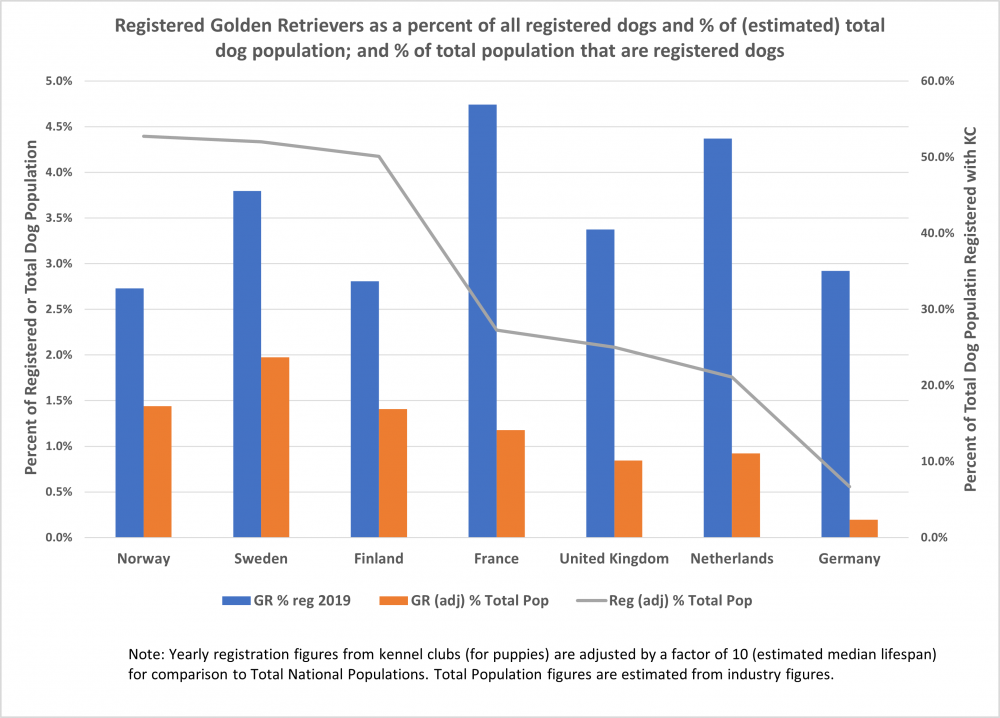
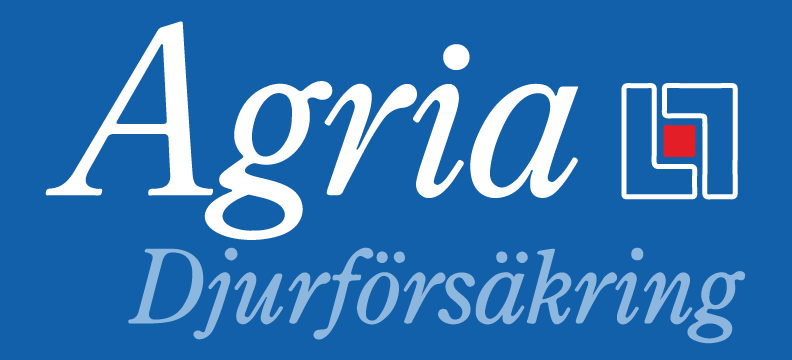
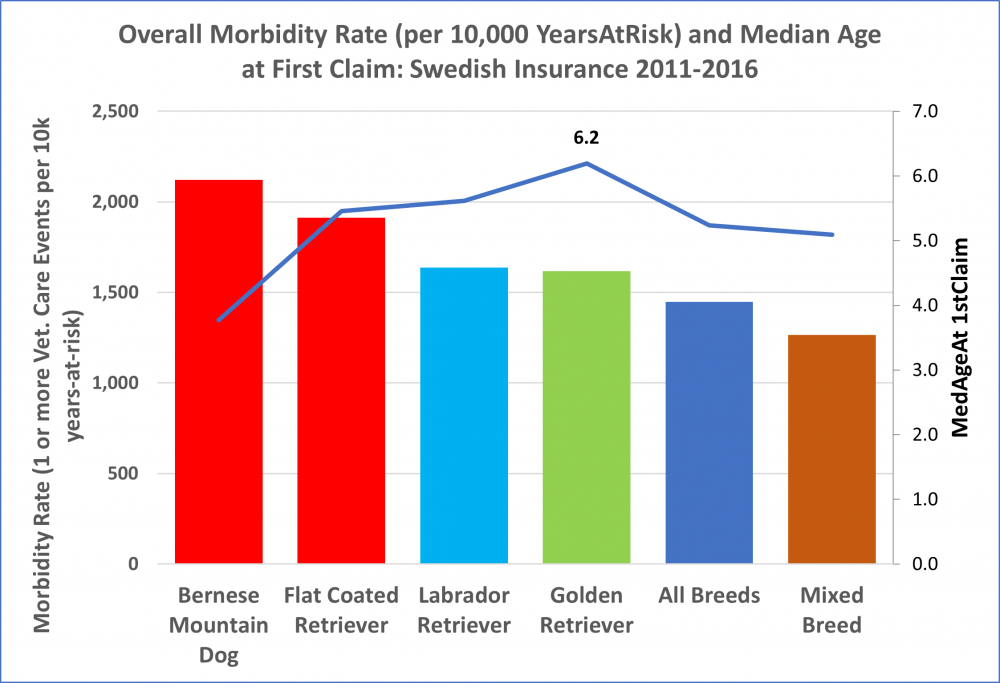
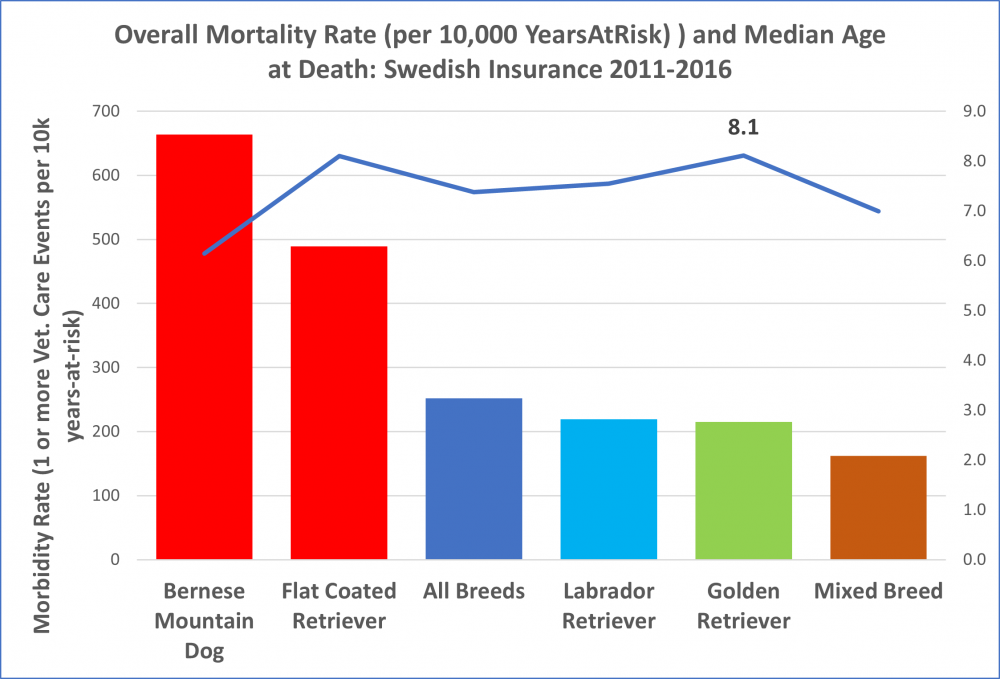
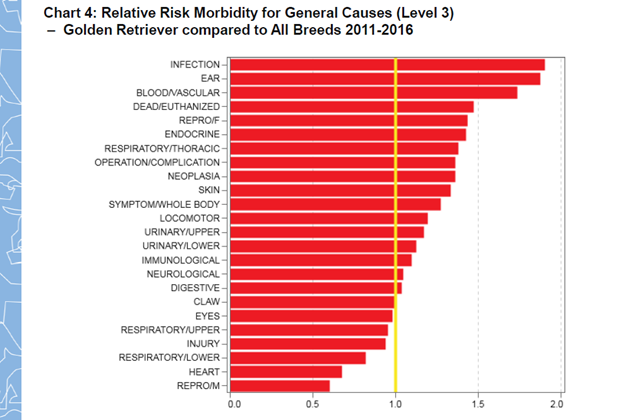
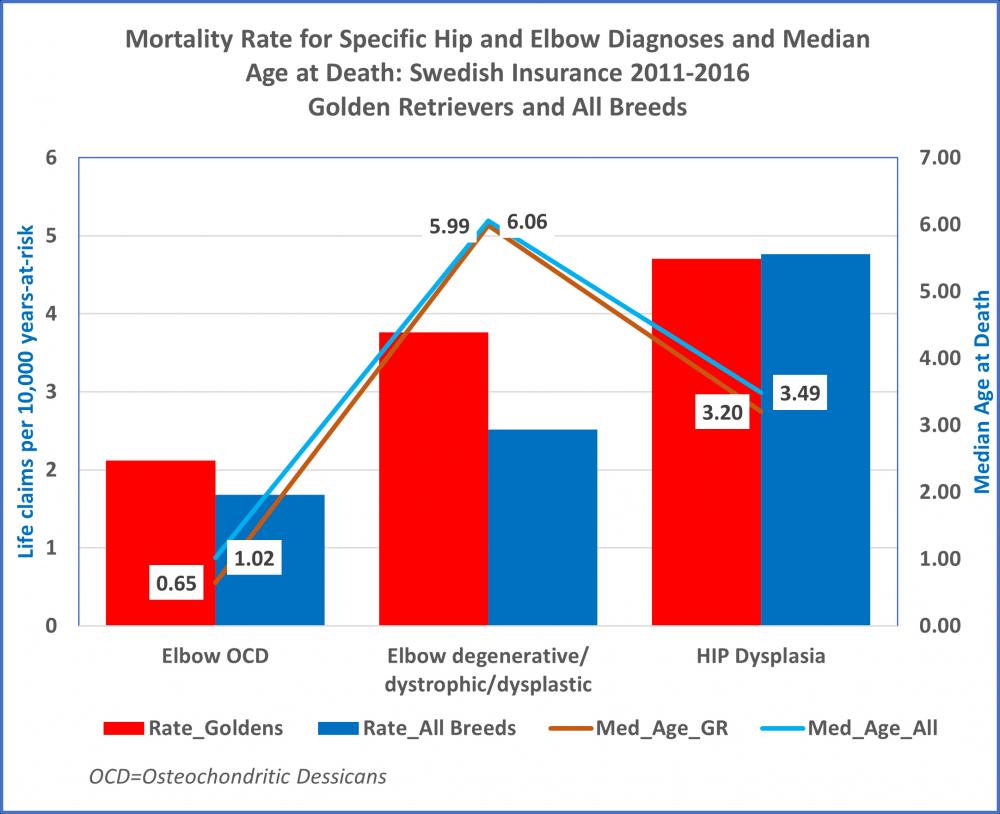
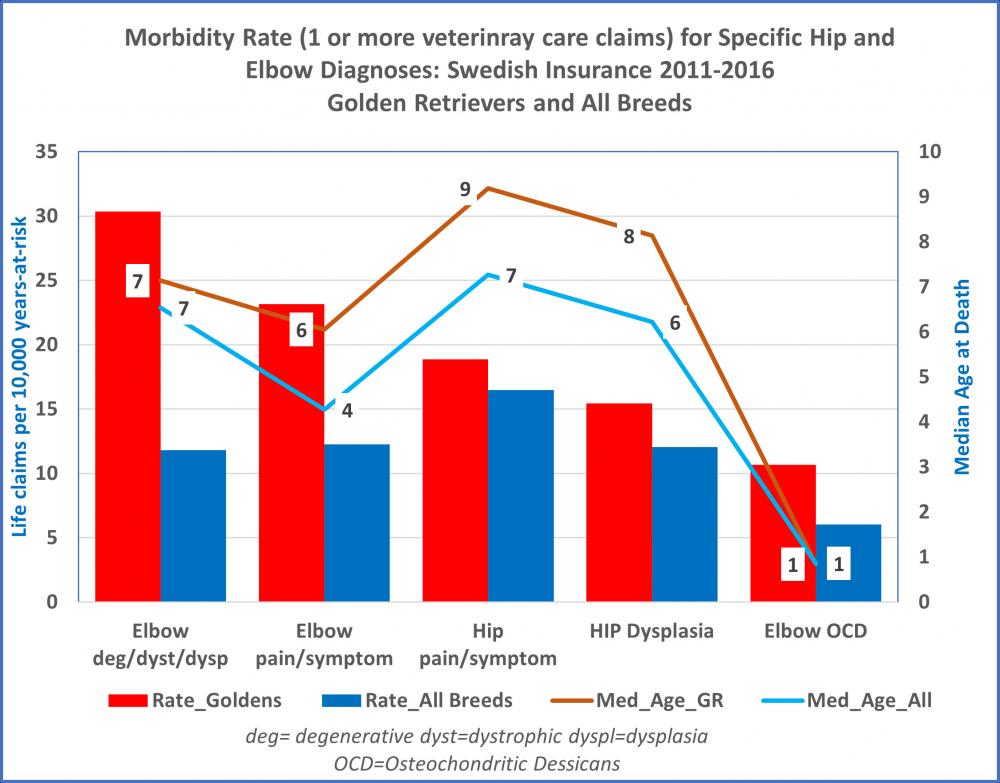
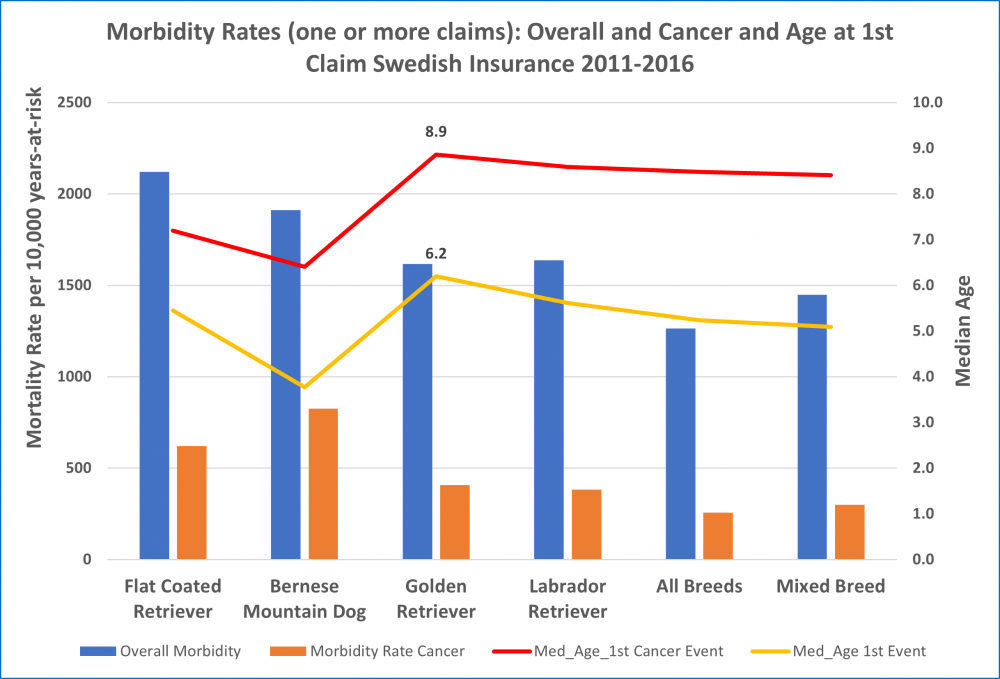
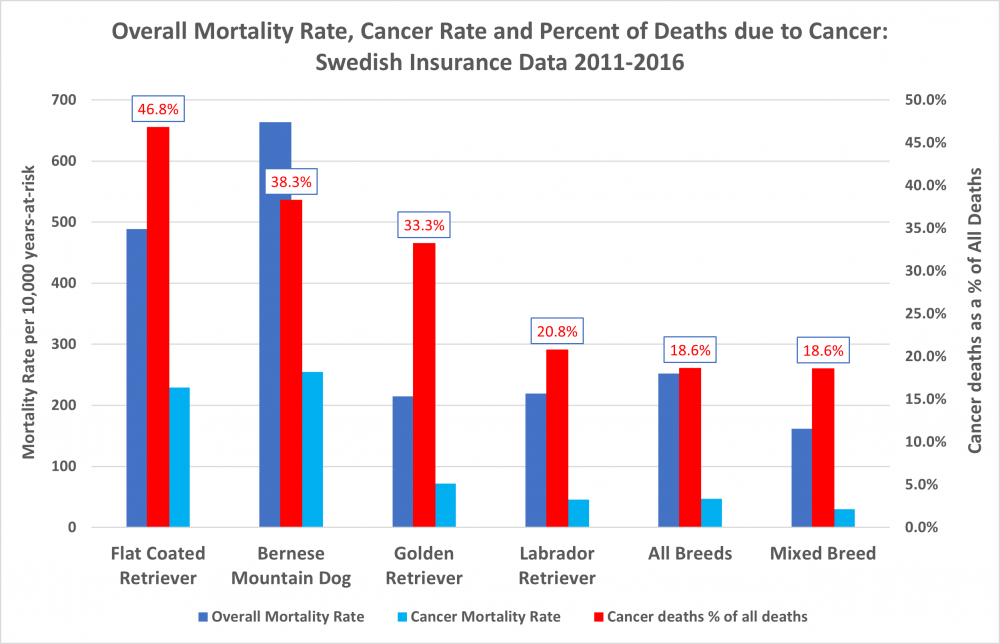
 Testing is required or recommended particularly if the condition is known to occur in a family line or symptoms are present. Some breeders or clubs may test for or track the condition; research and data on the condition is available (see below). OFA data shows 38,049 Goldens tested with 99.2% Normal, .5% Equivocal and .3% affected.
Testing is required or recommended particularly if the condition is known to occur in a family line or symptoms are present. Some breeders or clubs may test for or track the condition; research and data on the condition is available (see below). OFA data shows 38,049 Goldens tested with 99.2% Normal, .5% Equivocal and .3% affected.






Recommended Comments
There are no comments to display.
Join the conversation
You can post now and register later. If you have an account, sign in now to post with your account.
Note: Your post will require moderator approval before it will be visible.